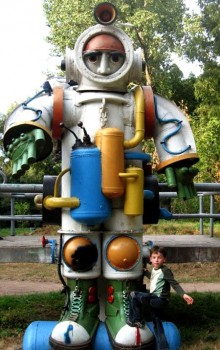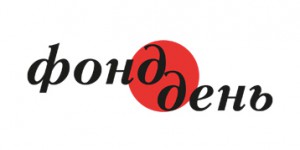Waste is the 21st century challenge. The problem is so urgent that even an expression “waste grabs us by the throat” has arisen. About 10 million tons of trash accumulate annually in Ukraine alone. At the beginning of the year, the coordinator of the Consumer Control Center “Check” Ihor Kanevsky provided the following data to journalists: only 1 or 2 percent is recycled out of 10 or 12 million tons of solid domestic waste that is produced every year. The state loses approximately one billion euro on it, says zahid.net. Almost 160,000 hectares of land are occupied with landfills. The scale of this problem increased so much that ecologists are not the only ones to raise the alarm. Students of the Zaporizhia National University sent a letter to The Day about the problem that is not being solved for decades, the absence of landfills and waste recycle system.
There are various ways of solving the problem: utilization, recycling, or incineration of waste. Or an absolutely different approach can be found, like the one practiced by Mykola Mazur, the creator of a playground made of scrap metal at the end of the 1970s in Khmelnytsky. In his conversation with The Day the artist noted: “Actually, there is no such thing as trash for an artist. There is an idea that can be implemented if this artist has enough imagination or the situation is favorable. I created my scrap metal art in Ukraine back when nobody even thought about doing it. When working on something, I used to imagine I was a child who played with pieces of metal. I went to a metal junkyard, looked around, there were thousands of tons of used things thrown away by civilization: machinery, airplanes, tanks, weapons… This is apocalypse. I saw how perfect those things were, how much work was put into their creation, and then, suddenly, they became useless. Every tiny detail was preceded with a colossal amount of civilization’s work. I started creating huge toys for children out of all that.” Nowadays, trash art is trendy in many countries. It does not just give “second wind” to used things, but also makes people think about their attitude towards the environment.
However, it is most important to teach the younger generation to treat resources with care.
About 10 million tons of waste accumulate in Ukraine annually. The Day offers several ways of dealing with the problem: utilization, recycling, incineration, or… transforming it into art.
There are 430 incineration plants in Europe today
The recent weather cataclysm covered Kyiv not only with snow, but also with domestic waste, because sanitary vehicles had no ability to do their regular routes, and there was no space for the bulky trucks to turn around in the yards buried in snow. But this is not the only problem related to garbage disposal and utilization. In particular, only one incineration plant (“Energy”) works in Ukraine. Does it have enough raw material? Is it profitable? What ecological potential does this type of utilization have? These and other questions were answered by Serhii KRYKUN, the company’s manager.
“We got used to the fact that Kyiv, or Kyiv transporters, to be more precise, never provide enough raw material. But we suffered from this even more during the bad weather days. By the way, we cleared all the access roads to the plant to make it easier for transporters to reach us. But we still lack waste for combustion. In order to operate in a normal way, we need to receive no less than 700 tons of solid waste per day. Before the last cataclysm, only about 350 to 400 tons were delivered, not more. That is why our plant is loss-making. Last year, the loss was 17.2 million hryvnias because of the lack of raw material. According to the project, we have to recycle 235,000 tons of trash. And we received only 146,000 tons in 2012 and 154,000 – in 2011. Starting from 2010, a constant decrease has been observed. At the moment the enterprise is using only 60 percent of its full operation capacity. In February, only 9,400 tons were delivered to us instead of the required 20,000 tons.
“Despite the fact that our equipment is functional, we follow all the ecological regulations, our employees are professional and hard-working, we cannot earn money for the reconstruction. Fortunately, we have enough to pay salaries, and that is only because we are a part of Kyivenerho. But this company is completely private now, it cannot fully take care of such public enterprise as ours.”
But Kyiv has been cleaned from waste now. Did you feel that through the increase of raw material supply?
“Yes, but still only two out of our four furnaces are operating now.”
How can you account for this situation?
“Transporters receive quotas and permits for domestic waste transportation. Permits indicate places of waste utilization, which can either be burying or recycling. Usually, one of the two places is indicated: ‘Energy’ plant or landfill No. 5. And the transporters can choose. But they do have other options. There is only one proper landfill in Ukraine – the one under number five. The rest are just dumps. There is a large number of them in Kyiv oblast. The harm they cause to the environment is horrifying. They are the reason of toxic matters filtering into underground water, unpleasant odors, occasional fires, probability of disease transmission by animals. Waste dumps are in almost all of the Kyiv oblast districts and are either rented or owned by the transporters. It is farther to take trash there, than to our plant, but it is more profitable, because they don’t have to pay there. That is why waste even from those districts that are located near our plant is taken there. Darnytsky, Desniansky, Dniprovsky districts should have cooperated with us only. And the city authorities should have controlled this, because upon receiving the utilization fees, we don’t only provide jobs (there are 200 workers at the plant), but also pay taxes.
“We charge comparatively little for our work: 127.5 hryvnias per ton of waste according to a rate, established in 2008. And the landfill charges over 100 hryvnias now, although the technology and expenses cannot even be compared. I am not sure how much they charge at dumps.”
What emission standards are established for the plant? Who controls them, and in what way? Do you plan to improve the level of emissions filtering at your plant?
“Every five years we receive special permits that contain emissions regulations that we have to follow. There is strict control over our plant. Scheduled and unscheduled inspections follow one another. With all the responsibility I can state that during the period our plant has been part of Kyivenerho (and that is more than 10 years), we have not exceeded the pollution standards a single time. Water vapor takes about 97 to 98 percent of gas emitted by our plant. However, people complain sometimes, saying they saw black smoke coming out of our pipe.”
How can this happen?
“There can be several reasons for that. Sometimes, it even depends on the boiler house, which uses natural gas, thus making the smoke look black. Everything depends on the angle at which you look at the smoke, weather, and time of the day. It also happens that a piece of rubber might accidentally get into a furnace. Then we have to find out how that could happen. And also, the homeless often make fires on the lakeshore not far from our plant. It looks like this smoke is coming from our plant if you view it from the side of Kharkivska Metro Station. In such cases we call firefighters, so we are not blamed for anything.
“However, our emissions are far from the European standards. That is why we have a design for an up-to-date filtering system, which already passed all necessary expert examinations. As soon as we install the proper equipment, our emissions will be reduced to European standards. I repeat once again, the design is ready. But the work on it is suspended at the moment. We have addressed all the ministries with a request to assign money from the budget. We need 139 million hryvnias. After we receive them, it will take some two years before this complex will be launched. But the money is not here yet…
“But an automatic environmental control system, which replaced the one that went out of order, will soon provide data about our emissions. There is already money for it. By the way, we also have a heat production project. But for the latter we need a bit more than 127 million hryvnias, which we do not have either, unfortunately.”
What is your opinion on separate waste collection? Is it possible to implement such an approach in Kyiv?
“I fully support this idea. But its implementation has to be supervised by the local authorities and carried out wisely. It is urgent to organize the collection of such hazardous objects as electric batteries and energy-saving lightbulbs. So far, we find them in the trash that comes in at the plant. It is extremely hard and expensive to extract them. A special municipal system of collection is required. Separate waste collection is not enough (at least, in its present state). Facilities for sorting waste should be created. And if after that we receive standard waste, we will be able to burn it without natural gas. Concerning the sorting immediately at the plant, it is quite problematic, in my opinion. Let us say, we extracted 20 percent of waste that can be burned effectively. But what should we do with remaining 80 percent? Transport it elsewhere? Unfortunately, nothing new was invented in this sphere except for thermal treatment. There are 430 incinerator plants in Europe today, which produce a huge amount of heat and electric energy, and 67 more of such enterprises are being designed and built.”
By Vitalii KNIAZHANSKY, The Day








